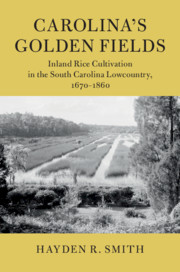Book contents
- Carolina’s Golden Fields
- Cambridge Studies on the American South
- Carolina’s Golden Fields
- Copyright page
- Dedication
- Contents
- Figures
- Table
- Acknowledgments
- 1 Introduction
- 2 Simple Reserves
- 3 The “Golden Mines of Carolina”
- 4 “To Depend Altogether on Reservoirs”
- 5 “The Rice Fields which Are Sown Have Been Partially Flowed”
- 6 Inland Rice Cultivation and the Promise of Agricultural Reform
- 7 Epilogue
- Appendix
- Bibliography
- Index
3 - The “Golden Mines of Carolina”
Expansion of the Inland Complex, 1730–1783
Published online by Cambridge University Press: 28 October 2019
- Carolina’s Golden Fields
- Cambridge Studies on the American South
- Carolina’s Golden Fields
- Copyright page
- Dedication
- Contents
- Figures
- Table
- Acknowledgments
- 1 Introduction
- 2 Simple Reserves
- 3 The “Golden Mines of Carolina”
- 4 “To Depend Altogether on Reservoirs”
- 5 “The Rice Fields which Are Sown Have Been Partially Flowed”
- 6 Inland Rice Cultivation and the Promise of Agricultural Reform
- 7 Epilogue
- Appendix
- Bibliography
- Index
Summary
Chapter 3 discusses the dramatic transformation of inland rice cultivation between 1730 and the end of the American Revolution as it coincided with the appearance of tidal irrigation. Spurred by the land boom, planters moved rice cultivation from small-stream floodplains down to broad inland basins. To build elaborate infrastructures on these low-lying wetlands, planters had to invest in additional enslaved labor. This chapter argues that the dramatic change in inland rice cultivation was modeled on planters’ development of tidal irrigation along the Lowcountry rivers throughout the mid-eighteenth century. Both the evolving inland system and emerging tidal system required more extensive labor forces than before to create precisely leveled fields, massive embankments, and extensive canals. Creating a more extensive irrigation and drainage network called for a sophisticated understanding of hydrology and soils. With the intense development of rice fields in the Lowcountry basins, inland planters also encountered new problems. Malaria, declining soil fertility, pests, freshets, and droughts all documented how the natural and the built environments could work at cross-purposes.
Keywords
- Type
- Chapter
- Information
- Carolina's Golden FieldsInland Rice Cultivation in the South Carolina Lowcountry, 1670–1860, pp. 52 - 92Publisher: Cambridge University PressPrint publication year: 2019



